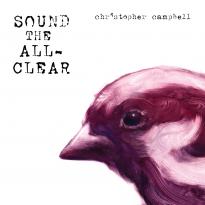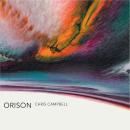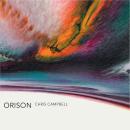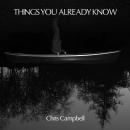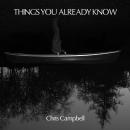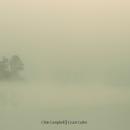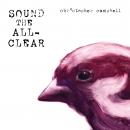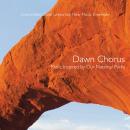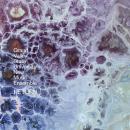Sound the All-Clear
Sound the All-Clear
Saint Paul, MN
There's a pan-global feel to Christopher Campbell's music that might be familiar to any time-traveler racking up the frequent flyer miles. Bowed koto and Fender Rhodes piano are as likely to make an appearance as a pseudo-Scottish patriotic song or the sound of a sparrow colony in the shrubbery near his house. It's altogether a luscious organic ritual that transcends studio, concert hall, epoch and continent; American Gagaku for the space age.
Sound the All-Clear is the first album by composer/film-maker Campbell and his visual sense bleeds through every imaginary sound-space. The 'all-clear' is a traditional signal in time of strife or tempest that the danger has passed and peace has returned to the land. The music on these 12 tracks seems to breathe post-apocalyptic relief as it cycles and settles, expands and contracts.
The unlikely ensemble brought together for the project features a dozen top pros (such as Todd Hammes, Susie Ibarra, Michelle Kinney and others) and enthusiastic friends happy to sing, fidget and groove to realize Campbell's cunningly-contrapuntal, architecturally-planned score. With its audiophile production quality every tinkle, chime and plunk sounds golden.
Christopher Campbell studied composition and film at Sarah Lawrence College and his teachers have included George Tsontakis and David Del Tredici. His music hits the Reboot button on classical music. He works at a record label in St. Paul.
See CD version, #750, for more Reviews
This CD doesn't just fall into the itchy-scratchy school of electro-acoustic music or sound sculpture, (always masterfully produced by the French or French Canadians), but plunks into a much broader context. First of all, there is a mischievous gothic quality--like an upside down Marilyn Manson /Trent Reznor of electro-acoustics, leading to an even broader historical framework including Partch and Crumb, to finally the biggest frame including Bartok's night music or Messiaen's slow dream movements. Also, As Campbell is a filmmaker, there is a strong surreal, visual allegory going on, similar to the work of Czech film maker Jan Svankmaier or a must lighter, less threatening Hieronymus Bosch. One has a sense of a camera panning over a large fresco or canvas focusing on one hyper-zoomed section then moving to the next.
Let me give you a brief overview of what's going on with the major pieces.
1. Sleepless Night
Right away, cool polyrhythms are created by a language that I could call `hanpster treadmill' music--mechanical, motion artifacts moving at different rates. It's like a Rauschenberg painting coming alive on your wall.
2. Sunface Streams Moon Face
Here Campbell is riffing on piano strings with excellent unifying use of pitch not unlike Varese or Partch. This pitched content is always dreamlike and unassuming. over the ever present `itchy-scratchy' frame. Also, reverb, different room miking, and panning are lavishly utilized.
3. All -Clear
This piece has a more delicate balance between pitch and noise, very reminiscent of Lachenmann string quartets yet without the austerity. The music is generous, lush, kaleidoscopic full of whimsy, without indulgence. This kind of good taste and refinement cannot be taught in any composition class.
6.Diamond Marimba
The work has gorgeous timbral-rythmic clashes utilizing Webern pauses to articulate the structure. It sounds analogues to the cross-rhythms produced by the insects and rodents behind the walls. There is definitely a kind of suspense horror movie ethos in there somewhere, but never over-burdening.
7.Imago
Campbell's pitch sense is on full display: very free of the weight of the western canon -at once intuitive and thought out. Most pitches are derived from small primitive patterns and multi-pitched drones. The piece is full of a kind of innocent joy in the discovery of clashing delicacies: sorbet with French mustard or milk with Tabasco sauce.
9. Shining Furrows
This gem is darker, with greater pitch density--over what sounds like a melodic lullaby in cello octaves. It is the perfect representation for the first class of Ethnomusicology 101; exploration of struck, plucked, friction, and blown, of idiophones, membranophones, chordophones, aerophones and electrophones
10.Ritual Walking
Here he begins with a focus on the ringing of various sized bells, zooming in on the vibrations and beating against other bells. This piece is much more confined to pitch this time, with drones and plucks on top. There is a ritualistic quality to this music--the religion of struck, plucked, friction, and blown.
In conclusion, Campbell has a real compositional voice and is destined to be a major player in American music. He exploits all schools of electro-acoustic music, from environmental, found objects, electronica, drone music. and primitive pitch cells. He never clearly shows his hand in turns of influence--other than he's just another rugged Rugglian outsider, only really found in American music.
-Mike Maguire, Amazon
